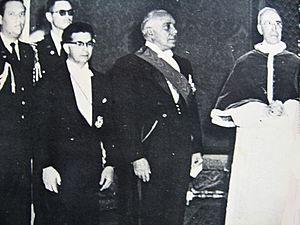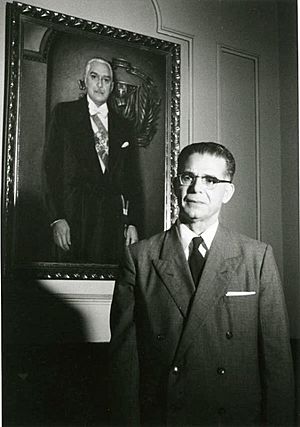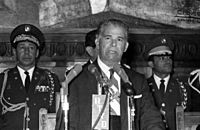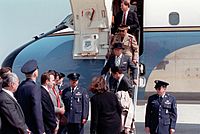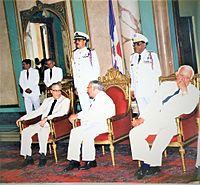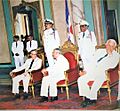Joaquín Balaguer facts for kids
Quick facts for kids
Joaquín Balaguer
|
|
|---|---|
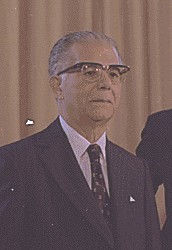
Balaguer in 1977
|
|
| President of the Dominican Republic | |
| In office 16 August 1986 – 16 August 1996 |
|
| Vice President | Carlos Morales Troncoso Jacinto Peynado Garrigosa |
| Preceded by | Salvador Jorge Blanco |
| Succeeded by | Leonel Fernández |
| In office 1 July 1966 – 16 August 1978 |
|
| Vice President | Francisco Augusto Lora Carlos Rafael Goico |
| Preceded by | Héctor García-Godoy |
| Succeeded by | Antonio Guzmán Fernández |
| In office 3 August 1960 – 16 January 1962 |
|
| Vice President | Rafael Filiberto Bonnelly |
| Preceded by |
|
| Succeeded by | Rafael Filiberto Bonnelly |
| Vice President of the Dominican Republic | |
| In office 16 August 1957 – 3 August 1960 |
|
| President | Héctor Trujillo |
| Preceded by | Manuel Troncoso de la Concha |
| Succeeded by | Rafael Filiberto Bonnelly |
| Personal details | |
| Born | 1 September 1906 Bisonó, Dominican Republic |
| Died | 14 July 2002 (aged 95) Santo Domingo, Dominican Republic |
| Political party | Independent (1924–1966) Social Christian Reformist Party (1966–1996) |
Joaquín Antonio Balaguer Ricardo (born September 1, 1906 – died July 14, 2002) was an important Dominican politician, writer, and lawyer. He served as President of the Dominican Republic three times. His terms were from 1960 to 1962, 1966 to 1978, and 1986 to 1996.
Balaguer was known for his quiet and private personality. He learned a lot from the time of Rafael Trujillo's rule. He wanted to stay in power, sometimes through elections that were questioned. His time as leader saw big changes. These included allowing political activities and improving health and education. He also made some land reforms.
Contents
Early Life and Start in Politics
Joaquín Balaguer was born on September 1, 1906. His birthplace was Navarrete, which is now called Villa Bisonó. This town is in the Santiago Province of the Dominican Republic. His father, Joaquín Jesús Balaguer Lespier, was from Puerto Rico. His mother, Carmen Celia Ricardo Heureaux, had French roots. Joaquín was the only boy in his family.
From a young age, Balaguer loved literature. He wrote poems that were printed in local magazines. He was taught by Rosa Smester Marrero, a well-known educator. Balaguer later said she greatly influenced his learning.
After school, Balaguer earned a law degree. He studied at the University of Santo Domingo. He also spent a short time studying in Paris, France. As a young man, he admired Pedro Albizu Campos, a political leader from Puerto Rico. Albizu's strong speeches inspired Balaguer. This showed his early interest in politics and discussions.
Balaguer's political career began in 1930. This was before Rafael Trujillo became the country's leader. Balaguer was first an Attorney in the Court of Properties. Later, he held many important roles. He was a Secretary in Madrid and an Ambassador to Colombia and Mexico. He also served as Secretary of Education and Foreign Relations.
First Time as President
In 1957, Rafael Trujillo chose Balaguer as vice-president. Trujillo wanted his brother, Héctor Trujillo, to be re-elected president. Three years later, Trujillo faced pressure from other countries. He decided it was not good to have a family member as president. So, Trujillo made his brother resign. Balaguer then became president.
Things changed a lot when Trujillo was killed in May 1961. Balaguer stayed president, but Trujillo's son, Ramfis Trujillo, held the real power. They tried to make the government more open. They allowed some civil liberties and eased censorship. However, people wanted more freedom. They did not remember the hard times before Trujillo.
At the same time, Ramfis's changes worried some strong supporters of Trujillo. These were led by Ramfis's uncles. Other countries continued to put economic pressure on the Dominican Republic. Ramfis warned that the country could face a civil war.
Balaguer spoke out against the harsh treatment of opposing parties. In September, he promised to form a government with different groups. Ramfis's uncles left the country in October. But opposition groups wanted Ramfis to leave too. Ramfis said he would resign if economic restrictions were lifted. They were lifted, but his uncles returned, hoping for a military takeover. Ramfis resigned and left the country on November 17. The United States sent ships and marines to the area. They were ready to help if Balaguer asked.
A general supported Balaguer and bombed forces loyal to Trujillo. The Trujillo brothers left the country again. A new general became Secretary of Armed Forces.
A group called the Union Civica Nacional (UCN) called for a national strike. They wanted a temporary government and delayed elections. The military did not want the UCN in power. The American consul helped both sides reach an agreement. In January 1962, a Council of State was formed. Balaguer led it, and it included UCN members. This council replaced the Congress and the President.
However, people continued to protest against Balaguer. On January 16, Balaguer resigned. The general staged a military takeover and arrested other council members. But the US supported the UCN, and a new strike began. The general was arrested two days later. The Council of State was restored, led by Rafael Filiberto Bonnelly. Balaguer went to live in New York and Puerto Rico.
Juan Bosch was elected president in 1962. This was the country's first free election. But he was removed from power by a military takeover seven months later. The country then went through a difficult time. In April 1965, the Dominican Civil War began. Some military officers wanted to bring Bosch back. The U.S. President Lyndon B. Johnson sent 42,000 U.S. troops to stop the fighting.
A temporary government announced elections for 1966. Balaguer returned to the Dominican Republic. He formed the Reformist Party. He ran for president against Bosch. Balaguer promised gradual and orderly changes. He quickly gained support and easily defeated Bosch.
"The Twelve Years" (1966–1978)
When Balaguer became president again, the nation was struggling. It had seen many years of unrest. People knew little about democracy or human rights. Balaguer tried to bring peace after the Trujillo era and the 1965 civil war. However, political killings still happened often.
He worked to fix the country's finances, which were in chaos. He also started a program for economic growth. He was easily re-elected in 1970. He won again in 1974 after changing the voting rules. This led the opposition to not take part in the election.
During his "twelve years" as president, Balaguer built many things. These included schools, hospitals, dams, and roads. He also oversaw steady economic growth. He funded public housing and expanded education. However, his government became more controlling. Political opponents were sometimes jailed or killed. Opposition newspapers were sometimes taken away. But his rule was not as harsh as Trujillo's.
Defeat and Return to Power
In the 1978 election, Balaguer wanted another term. But prices were rising, and many people had not benefited from the economic growth. Balaguer ran against Antonio Guzmán Fernández. When election results showed Guzmán winning, the military stopped counting votes. However, after strong protests at home and pressure from other countries, the counting started again. Guzmán won, giving Balaguer his first election loss.
When Balaguer left office in 1978, it was a historic moment. It was the first time a sitting president in the Dominican Republic peacefully gave up power to an elected opponent.
In the 1982 elections, Balaguer lost again. He had joined his party with another to form the Social Christian Reformist Party.
Balaguer ran again in the 1986 elections. He won the presidency after an eight-year break. He was 80 years old and almost completely blind due to glaucoma.
Third Presidency
Balaguer's third time as president was much more open. He was more accepting of opposition parties and human rights.
He started many large building projects. These included highways, bridges, schools, and hospitals. Like Trujillo, he made sure these projects were well-known. They were shown on government media and at big public events. This helped make Balaguer popular. These projects also helped his political supporters get profitable contracts. The economy also got much better.
Balaguer was re-elected by a small margin in the 1990 elections. He beat his old rival, Juan Bosch, by only 22,000 votes. There were claims of fraud during this election.
For the 500th anniversary of Christopher Columbus' arrival in the Americas, Balaguer spent millions. He restored parts of historic Santo Domingo. He also improved areas of the city for the visit of Pope John Paul II. This included building a new grand avenue with modern homes.
A more debated project was the Columbus Lighthouse. Balaguer spent two hundred million US dollars to build this huge ten-story lighthouse. It was finished in 1992. The lighthouse was designed to shine a Christian cross into the night sky. It was meant to be seen for many miles. The Columbus Lighthouse is a small tourist spot. It is said to hold Columbus's remains. Its light is rarely used because of very high energy costs and frequent power outages in the country.
In the 1994 elections, Balaguer decided to run again. He was almost 90 years old and completely blind. His main opponent was José Francisco Peña Gómez.
The election campaign was very tough. Balaguer often used Peña Gómez's Haitian background to his advantage. Dominicans have historically been wary of anyone with Haitian roots. Balaguer claimed Peña would try to merge the country with Haiti if elected. When the results were announced, Balaguer was declared the winner by only 30,000 votes. However, many supporters of Peña Gómez found their names missing from voter lists. Peña Gómez claimed fraud and called for a general strike. Protests happened to support the strike.
An investigation later showed problems with the election. The election board did not know the total number of registered voters. Voting lists at polling places did not match those given to the parties. About 200,000 people had been removed from the lists. Because of these questions, Balaguer agreed to hold new elections in 1996. He would not be a candidate in these new elections. This was the first presidential election since 1966 without Balaguer on the ballot.
In the 1996 elections, Balaguer's vice president did not make it to the final round. Balaguer then supported Leonel Fernández from the Dominican Liberation Party. This was an unusual alliance with Bosch, his political opponent for over 30 years.
Later Life and Legacy
In 2000, Balaguer ran for president again. He could not walk without help, but he still joined the campaign. He knew his many supporters could make a difference. He won about 23% of the votes in the election. He just missed getting into the runoff election. Balaguer said he accepted the election results. The other candidate won the presidency.
On July 14, 2002, Joaquín Balaguer passed away at age 95. He died from heart failure in Santo Domingo.
He was a figure who caused strong feelings. People either loved or disliked him. Despite being seen as a strong leader, Balaguer also left a legacy as a great reformer. His land reform policies were praised for giving land to farmers. This earned him support from people in the countryside.
Ronald Reagan once said that President Balaguer helped his country become democratic. He called him "the father of Dominican democracy." Jimmy Carter also praised him. Carter said Balaguer set an example for leaders by changing his country from a controlling government to a more democratic one.
A metro station in Santo Domingo is named after Balaguer. He is also a main character in the novel The Feast of the Goat by Mario Vargas Llosa.
Images for kids
Template:KIDDLE XL START
See also
 In Spanish: Joaquín Balaguer para niños Template:KIDDLE XL END
In Spanish: Joaquín Balaguer para niños Template:KIDDLE XL END


